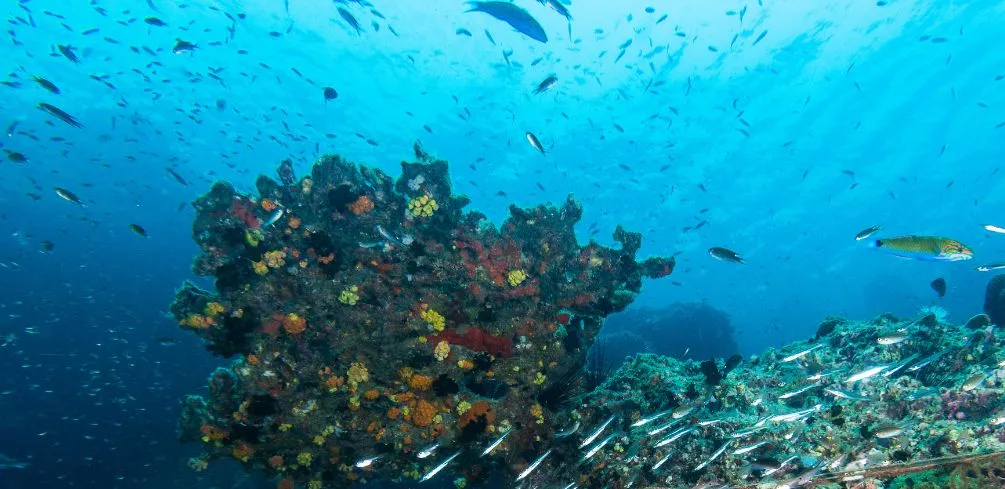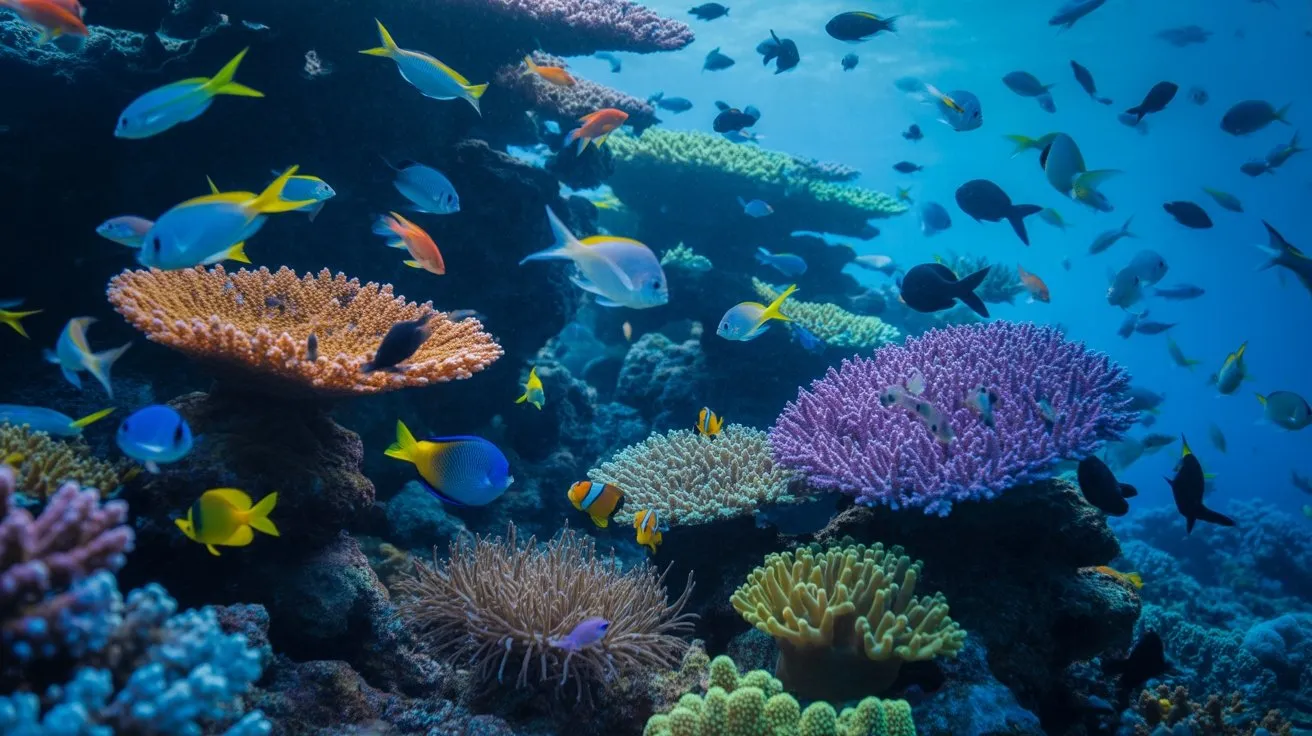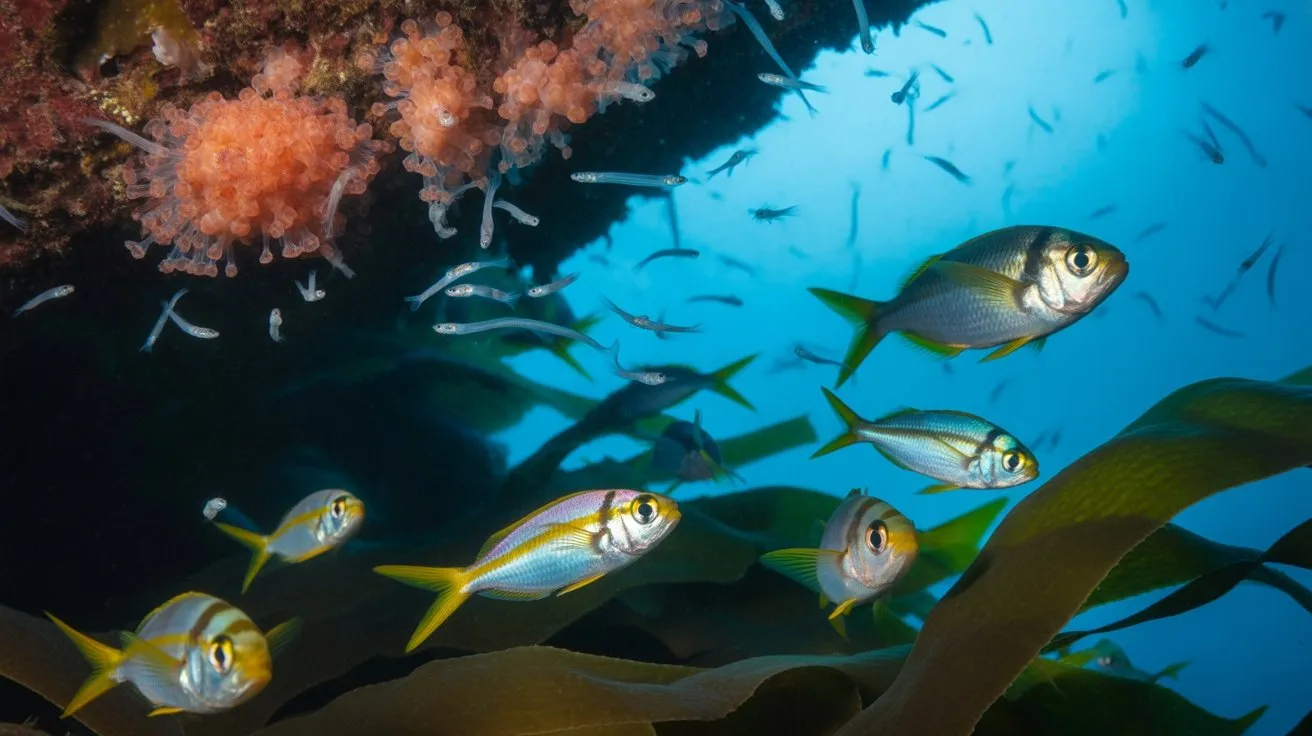Have you ever wondered what lies beneath the depths of the ocean? What creatures lurk in the darkness, hidden from our eyes? One of the most fascinating and diverse groups of animals living in our oceans is marine fish.
These incredible creatures come in all shapes and sizes, with a wide range of adaptations that allow them to survive and thrive in their environment. In this article, we will explore the diversity of marine fish and how they have adapted to life underwater.
Our oceans are home to thousands of species of marine fish, from tiny clownfish to giant whale sharks. Each species has evolved unique features that help them survive in its particular environment.
For example, many species have developed camouflage to hide from predators or become invisible against their background. Others have sharp spines or bright colors as a warning sign for potential predators. No matter where they live, these creatures have adapted to survive and thrive in their aquatic habitats.
The world’s oceans are a captivating place filled with mystery and awe-inspiring beauty. By exploring the diversity of marine fish, we can gain insight into how they interact with each other and their environment – something that will undoubtedly leave us feeling wonderstruck at nature’s brilliance!
Join us as we dive deep into these mysterious depths and uncover some amazing secrets about marine life!
Classification Of Marine Fish
The ocean is a vast and mysterious world, filled with creatures of all shapes and sizes. Among them is the incredible array of marine fish, creatures that have been captivating us for thousands of years.
But what are the different types of marine fish, and how do we classify them? This article will explore the exciting world of marine fish classification, from taxonomy to phylogeny.
The study of marine fish classification is known as fish systematics, which can be broken down into two main categories: species classification and phylogeny. Species classification focuses on the types of species within one genus or family, while phylogeny looks at how different groups of related species are related to each other. In both cases, scientists use anatomy and genetics to classify marine fish into various categories.
In terms of taxonomy, there are several main groups used in classifying marine fish: bony fishes (Osteichthyes), cartilaginous fishes (Chondrichthyes), cephalopods (Cephalopoda), and ray-finned fishes (Actinopterygii).
From these broad categories, scientists can further break down the species into families and genera that share similar characteristics. By studying these characteristics and comparing them against one another, scientists can build a phylogenetic tree that shows how closely different groups are related to each other.
Marine fish classification is an ever-evolving field as new species are discovered every day. By understanding the diversity of these creatures through systems such as taxonomy and phylogeny, we can gain a better appreciation for their unique beauty and complexity.
Habitats And Behaviors Of Marine Fish
Now that we have an understanding of the classification of marine fish let’s explore the habitats and behaviors that these creatures exhibit. Marine fish inhabit a wide variety of environments, ranging from shallow waters near coral reefs to the deep sea. Their behavior is equally as diverse and can vary greatly depending on where they live.
Here’s a look at some of the key characteristics associated with marine fish habitats and behaviors:
- Marine Fish Habitats
- Coral Reefs: These vibrant ecosystems are home to many species of tropical fish that rely on coral for food, shelter, and breeding grounds.
- Deep Sea: The ocean depths are home to unique species adapted to living in extreme pressure and darkness.
- Ocean Currents: Open ocean areas with strong currents provide plenty of food sources for mobile predators such as tuna and marlin.
- Marine Fish Behaviors
- Feeding: Many species feed on plankton or smaller fish, while others hunt with lightning speed in packs or unsuspecting ambush prey.
- Migration: Some fishes migrate great distances through open oceans in search of new feeding grounds or warmer climates for spawning purposes.
- Reproduction: Many species reproduce through external fertilization, releasing eggs into the water, which are then fertilized by sperm released by males nearby.
By examining the habitats and behaviors of marine fish, we get a better appreciation for their incredible diversity and complexity within their respective ecosystems. From coral reef dwellers to deep sea predators, each species has evolved specialized characteristics that allow them to thrive in their environment – something we can learn from and be inspired by!
Anatomy And Physiology Of Marine Fish
The anatomy and physiology of marine fish are incredibly diverse. From their gill structure to their eye structure and body shape, no two fish are the same; they all possess unique adaptations that allow them to survive and thrive in different environments.
Gill structures are highly variable between species and can range from simple slits on the sides of a fish’s head to intricate plates containing hundreds of finger-like filaments. These structures allow the fish to draw oxygen from their watery environment.
Eye structure is also incredibly varied, with some species having eyes on either side of their head while others have eyes protruding upwards or downwards. No matter what the shape and size of a fish’s eyes are, they are all designed for optimal underwater vision.
In addition to gills and eyes, marine fish also have an array of body shapes and muscle structures which enable them to move through water with ease. From torpedo-shaped bodies perfect for streamlined swimming to eel-like bodies that can twist and turn quickly through tight spaces, there is no one “right” body shape for a species; each type has its own advantages depending on its environment.
Finally, fin shapes vary greatly between species as well; some have large fins for stability, while others have small fins for agility when chasing prey or evading predators.
The vast array of anatomy and physiology among marine fish ensures each species has unique adaptations suited perfectly for its environment – something that sets them apart from other animals on land or in freshwater habitats.
Threats To Marine Fish Diversity
The diversity of marine fish is threatened in multiple ways. Marine pollution, overfishing, and climate change are some of the biggest culprits. Pollution from industrial runoff, agricultural runoff, and oil spills can have a devastating impact on ocean ecosystems.
Overfishing has also been known to deplete populations of certain species and disrupt the balance of marine ecosystems. Climate change is another major threat to the diversity of marine fish. Rising temperatures can lead to coral bleaching and ocean acidification, which negatively impacts many species that rely on coral reefs for shelter.
In addition to these large-scale threats, small-scale activities like recreational fishing and boating can also have an effect on the local population of marine fish. Boats leave behind trash that can contaminate water and hurt wildlife, while fishing gear such as nets can get tangled in coral reefs or seagrass beds, damaging habitats and hurting populations.
It’s clear that humans have played a role in threatening the diversity of marine fish, but there are things we can do to help protect them. We need to be aware of our actions and their potential impacts on marine life.
People should support sustainable practices like limiting their seafood intake to reduce overfishing, avoiding single-use plastics, picking up trash when they see it in nature, and participating in beach cleanups whenever possible. Taking these steps will help ensure that future generations will be able to enjoy healthy oceans full of diverse marine life for years to come.
Marine Fish Conservation Efforts
Today, fortunately, conservation efforts are underway to protect marine fish diversity. These initiatives include marine conservation, fish conservation, ocean conservation, coral reef conservation, and coastal conservation.
The first priority in conserving marine fish diversity is to reduce the threats that are causing its decline. This includes things like reducing overfishing and pollution, controlling invasive species, and protecting important habitats like coral reefs. Governments can also help by implementing sea-use plans and creating protected areas in the ocean where fishing and other activities are restricted or prohibited.
Marine protected areas (MPAs) are a great way to conserve marine biodiversity. MPAs provide refuge for endangered species, protect fragile habitats from destruction, and allow for the recovery of injured populations of fish. Additionally, they can also be used as a tool for education and research into marine ecosystems.
Fortunately, there is growing awareness of the need to conserve our oceans, and many countries have taken steps toward protecting their coastal waters by establishing MPAs and other initiatives. In the future, we will have to continue to work together to ensure that our planet’s incredible marine diversity is preserved for generations to come.
Frequently Asked Questions
What Is The Economic Value Of Marine Fish?
Have you ever wondered what the economic value of marine fish is? It’s an essential part of the global economy and a vital source of food.
From fishing industry economics to fish farming, there are many ways marine fish can contribute to our society. Let’s take a closer look at the economic value of marine fish and all it entails:
When it comes to fishing industry economics, research has found that the total economic output of commercial fisheries in the U.S. is over $253 billion each year. This includes everything from boat purchases and maintenance to salaries paid to fishermen, making the fishing industry a major contributor to our economy. Additionally, recreational fishing is estimated to generate more than $51.2 billion annually in total economic output.
The fish market itself also contributes greatly to our economy through exports as well as domestic sales. The global seafood trade generates an estimated $116.8 billion annually and employs millions of people worldwide.
Fish farming plays a large role in this trade, with aquaculture contributing nearly one-third of all seafood consumed globally today. Fish farming can be done both on land and at sea, with many countries relying heavily on aquaculture for their own domestic consumption needs as well as for export revenues.
The importance of marine fish cannot be overstated when it comes to economics–and its impact reaches far beyond just providing us with food or income for fishermen or farmers.
Here are four other key benefits marine fish bring:
- They provide essential nutrients and vitamins for human nutrition;
- They act as natural filters that help keep our oceans clean;
- They support biodiversity by providing habitat for other species; and
- They can help reduce climate change by absorbing carbon dioxide from our atmosphere.
Marine fish have immense economic value due to their wide range of uses–from providing food and employment opportunities to helping sustain our environment and ecosystems. With so much at stake, we must continue finding ways to protect these resources while still maintaining their critical contributions to society’s well-being.
What Are The Best Fishing Spots For Marine Fish?
Finding the best fishing spots for marine fish can be a challenge, but it’s worth the effort. Ocean fishing, saltwater fishing, and deep sea fishing are all ways to catch different types of fish in the ocean.
Here are three tips to consider when searching for great places to cast your line:
- Look for locations that offer diverse species of marine fish.
- Research popular saltwater or deep-sea fishing spots in the area you plan to visit or live near.
- Utilize online resources and forums to get advice from other anglers on where they’ve had success catching marine fish.
No matter your experience level as an angler, finding good fishing spots is essential for a successful day out on the water. Experienced fishermen know that being able to identify ideal areas where baitfish congregate makes it easier to locate larger game species such as billfish, tuna, marlin, and more.
Try looking for areas with structures like reefs, ledges, seamounts, and wrecks, which serve as homes for a wide variety of marine life. Inshore locations such as bays and estuaries provide excellent opportunities for anglers of all skill levels to catch a variety of inshore species like a red drum (redfish), speckled trout, and flounder from shore or from a boat.
Fishing is not just about reeling in something big; it’s also about having fun and enjoying nature at its finest – so don’t forget to take some time to appreciate your surroundings while you’re out there!
Armed with proper knowledge and gear, combined with patience, practice, and persistence will help make yourself an experienced angler who knows their way around various fishing spots seeking those elusive marine fish!
How Can I Cook Marine Fish?
Cooking marine fish can be an incredibly delicious and rewarding experience. With the right techniques, flavors, and methods, you can bring out the unique taste of these ocean-dwellers for a tantalizing treat.
Whether you’re looking to pan-fry, grill, bake, steam, or poach your marine fish, here’s how to make the most of your catch:
• Pan-frying: Heat oil in a large skillet over medium heat. Season fish with salt and pepper before adding it to the skillet. Cook until golden brown on both sides.
• Grilling: Preheat a gas or charcoal grill to medium-high heat. Grease grates and season fish lightly with salt and pepper before adding it to the grill. Grill until opaque throughout (about 4 minutes per side).
• Baking: Preheat oven to 375°F (190°C). Place seasoned fish onto a baking sheet lined with parchment paper or aluminum foil. Bake for about 15 minutes, depending on the thickness of the fillet.
• Steaming: Place a steamer basket into a pot filled with 1/2 inch of water. Bring water to a boil, then add seasoned fish fillets into the basket. Cover and steam for 5–7 minutes until done.
• Poaching: In a wide saucepan, bring 2 inches of salted water to a gentle simmer over medium heat. Add fish fillets one at a time and cook slowly until opaque throughout (about 8 minutes).
No matter which method you choose, cooking marine fish is simple but requires attention as they are delicate in texture and flavor compared to other types of seafood like shellfish or mollusks.
To ensure the best results when preparing your meal, pay attention to timing, as overcooking will dry out your dish quickly. Also, don’t forget the presentation – plate up your seafood in creative ways that will enhance its beautiful colors and flavors!
What Is The Most Common Type Of Marine Fish?
When it comes to marine fish, there’s a lot of variety out there. From species like tuna and cod to lesser-known varieties such as sardines and mackerel, the possibilities are seemingly endless. But if you’re looking for the most common type of marine fish, there are a few that stand out above the rest.
To start, let’s look at some key characteristics of common marine fish. Generally speaking, they tend to be smaller in size compared to freshwater species and have adapted to survive in saltwater environments.
Additionally, they can be found near the coasts and estuaries around the world, with certain species being more abundant in certain regions than others.
So what are some of the most common types of marine fish? Here’s a list:
- Tuna
- Cod
- Mackerel
These three species tend to be among the most widely available types of marine fish, both commercially and recreationally. Tuna is often used in sushi dishes and is also frequently canned for easy storage and eating on the go.
Cod is a popular choice for many seafood dishes, while mackerel provides an excellent source of omega-3 fatty acids for health-conscious eaters. All three can be cooked in various ways depending on your preference – from grilling and baking to frying or even smoking!
No matter how you choose to prepare them, these three types of marine fish provide delicious meals packed with nutrients that will satisfy any seafood lover’s palate. With such wide varieties available, it’s no wonder they remain one of the most popular options when cooking up something special with your catch!
What Are The Health Benefits Of Eating Marine Fish?
Eating marine fish can be beneficial to your health. It is a great source of nutrition and has some unique benefits that other types of food cannot offer. We’ll explore the health benefits of eating marine fish and why it should be part of your regular diet.
When it comes to nutrition, marine fish are one of the most nutrient-dense foods you can eat. They are packed with essential vitamins and minerals like omega-3 fatty acids, vitamin D, and selenium which aid in boosting the immune system and reducing inflammation.
Eating fish regularly can also help lower cholesterol levels and reduce the risk of heart disease and stroke. In addition to these health benefits, seafood contains two crucial nutrients that many other foods lack: iodine and zinc. Iodine helps the body absorb calcium for healthy teeth and bones, while zinc helps support a healthy immune system.
In addition to its nutritional value, eating marine fish can also provide mental health benefits as well. Studies have shown that consuming omega-3 fatty acids from fish can improve moods and reduce stress levels.
Eating seafood has even been linked to improved cognitive functioning in adults due to its high levels of omega-3 fatty acids, vitamin B12, choline, and folate, which all play an important role in brain function.
For anyone looking for a healthy way to add more protein to their diet or get more nutrients out of their meals, adding marine fish to their diet is a great option. Not only will they get all the nutritional benefits discussed above, but they will also reap the mental health benefits associated with eating seafood as well. It’s a win-win situation!
Conclusion
The economic value of marine fish is indisputable. Fishing spots around the world, from the Mediterranean to the Indian Ocean, provide ample opportunities for anglers to catch a wide variety of fish species.
From snapper and grouper to mackerel and tuna, there’s something for everyone. Learning how to cook these delicious varieties of marine fish can be a challenge, but with some practice and patience, even novice cooks can master it.
By exploring the diversity of marine fish available to us, we can gain an appreciation for both their economic value and health benefits. Not only do they provide us with sustenance through tantalizing flavors, but they also offer invaluable insight into our environment – like a window into an ancient underwater world full of wonders that remain largely undiscovered.
With each cast I make, I am reminded of how truly beautiful our planet is; it’s an awe-inspiring experience that I wouldn’t trade for anything else in this world.





